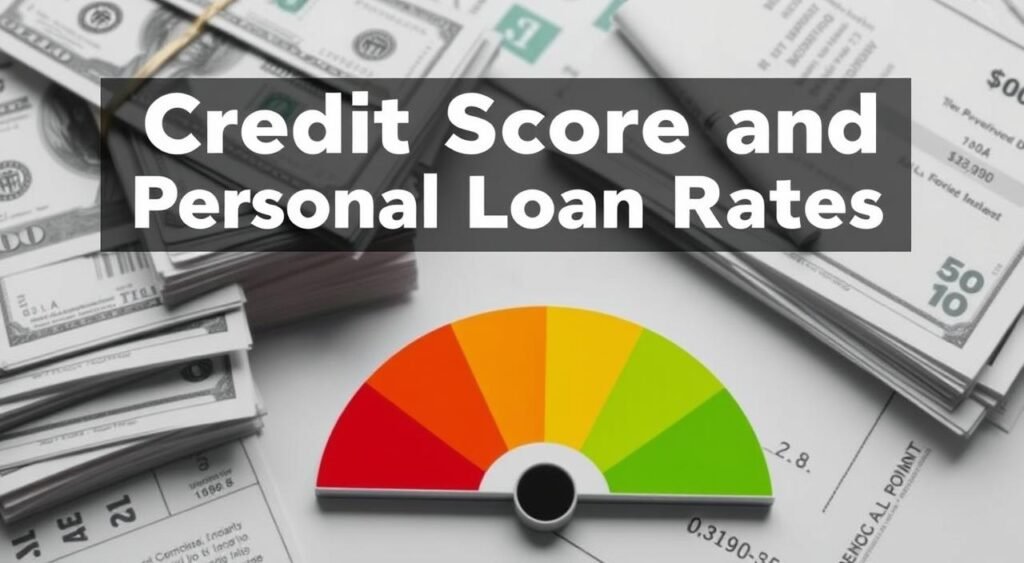Financial emergencies can happen when we least expect them. I remember when my car broke down on the way to a job interview. With no savings, I felt trapped and overwhelmed. That’s when I found out about personal loans.
These loans can be a lifeline in tough times. They help with unexpected expenses or high-interest debt. Personal loans have changed to meet different financial needs.
They range from $1,000 to $100,000. Interest rates vary from 6.99% to 35.99%. Repayment terms can be from 24 to 84 months. Your credit score affects your eligibility and the rates you get.
Finding your way through personal loans can be confusing. There are many lenders with different terms. It’s important to know what lenders look for.
From credit unions to online lenders, each has its own rules. Shopping around is key to getting the best deal.
As you look for a personal loan, knowing the details is crucial. Understanding loan terms, APRs, and repayment schedules can save you a lot of money. Let’s explore how to find the right rates for your financial situation.
Key Takeaways
- Personal loans offer amounts from $1,000 to $100,000
- APRs range from 6.99% to 35.99%, influenced by credit scores
- Loan terms typically span 24 to 84 months
- Credit score requirements vary by lender
- Some lenders offer same-day funding and no origination fees
- Shopping around is crucial for finding the best rates
- Understanding loan terms can lead to significant savings
Understanding Personal Loans
Personal loans are a flexible way to get money for different needs. You get a lump sum to pay back in fixed monthly payments over a set time. Let’s explore how personal loans work.
What is a personal loan?
A personal loan is a type of credit for almost any need. Loan terms range from one to seven years, with amounts from a few hundred to $100,000. Your credit score affects the interest rate, with better scores getting lower rates.
Types of personal loans: secured and unsecured
There are two main types: secured and unsecured loans. Secured loans need collateral, like a car or savings. Unsecured loans don’t need collateral but have higher interest rates. Your choice depends on your financial situation and the loan application requirements.
Common uses for personal loans
People get personal loans for many reasons. Some common uses include:
- Debt consolidation
- Home improvements
- Emergency expenses
- Wedding costs
- Vacation funding
When looking at personal loans, compare offers from different lenders. This helps you find the best rates and terms. Also, improving your credit score can help you get better loan terms.
“A personal loan can be a useful financial tool when used responsibly. Always borrow only what you need and can afford to repay.”
Factors Affecting Personal Loan Rates

Personal loan rates depend on several factors that lenders look at. These factors help them understand your risk level. Knowing these can help you get better loan terms and lower interest rates.
Credit Score Impact
Your credit score is key in setting your loan’s interest rate. Those with scores of 780 or higher might get rates between 13% and 19% for three-year loans. On the other hand, scores below 599 could lead to rates up to 32.51% for the same term. To get a better rate, work on raising your credit score before applying.
Income and Debt-to-Income Ratio
Lenders check your income and debt-to-income ratio to see if you can repay the loan. A higher income usually means lower rates, showing you’re financially stable. A good debt-to-income ratio also helps, indicating you’re not too deep in debt.
Loan Term and Amount
The loan term and amount you choose also impact your rate. In September 2024, three-year loans averaged 15.23% APR, while five-year loans were 21.95% APR. Shorter terms and smaller amounts often mean lower rates. Use a loan calculator to explore different options and find the best fit for you.
“Tips for getting a better rate on personal loans include improving credit scores, maintaining a healthy debt-to-income ratio, opting for a shorter repayment term, and shopping around or comparing quotes from multiple lenders.”
By understanding these factors and meeting lender criteria, you can get the best personal loan rates. Always compare offers from different lenders to find the best deal.
Top Personal Loan Lenders and Their Offerings
Finding the best credit card consolidation personal loans can be tough. Many lenders offer personal loans with different terms and rates. Let’s explore some top choices.
Upstart is great for those with thin credit histories. They provide loans up to $50,000 through an easy online application. Discover Personal Loans excels in debt consolidation, making direct payments to creditors.
SoFi offers large personal loans up to $100,000 with competitive rates. Their online application process is streamlined, making it easy for borrowers. LightStream specializes in home improvement loans with APRs starting at 6.99%.
It’s important to note that personal loan interest rates have been rising. This is due to Federal Reserve rate hikes. However, recent projections suggest potential rate cuts in 2024. This could lead to more favorable terms for borrowers.
- APR ranges: 6.99% to 35.99%
- Loan amounts: $1,000 to $100,000
- Minimum credit scores: Vary by lender
When choosing a lender, consider more than just interest rates. Look at loan amounts, funding speed, and whether collateral is required. Some lenders offer same-day funding after approval, while others may take up to four business days.
Remember, your credit score is key in determining your loan terms. Borrowers with higher credit scores often qualify for lower rates and larger loan amounts. Always compare offers from multiple lenders to find the best personal loan for your needs.
Personal Loan Benefits and Drawbacks

Personal loans are key in personal finance, offering a flexible solution for many needs. Knowing their pros and cons is crucial for smart borrowing decisions.
Benefits of Personal Loans
Personal loans have many benefits. They often have fixed interest rates, from 6% to 36% APR, for easy monthly payments. Loan amounts range from $1,000 to $100,000, meeting different financial needs. Quick funding is common, with some lenders offering same- or next-day access.
These loans are great for debt consolidation, home improvements, and even student loans. For those with good credit, they offer competitive rates, making them a smart choice.
Potential Drawbacks to Consider
Despite their benefits, personal loans have downsides. Those with lower credit scores may face higher rates, increasing borrowing costs. Loans can also come with fees like origination fees (1% to 6% of the loan amount), application fees, and penalties for late or missed payments.
- Higher expenses compared to home equity loans or 0% APR credit cards
- Possible negative impact on credit scores if payments are missed
- Risk of accumulating more debt if not managed responsibly
Comparing Personal Loans to Other Financing Options
When looking at personal loans or other financing options, it’s important to compare. Personal loans offer flexibility and lower rates than credit cards. But, secured loans like home equity loans might have better rates for homeowners. For education, federal student loans often have better terms than personal loans.
“A personal loan offers a lump sum of money with a fixed rate and predictable payment schedule, making it a suitable option for various financial needs.”
The right choice depends on your financial situation, credit score, and needs. Evaluating all options carefully helps find the best financing for your goals.
How to Apply for a Personal Loan

Getting a personal loan is easy. First, you need to know what lenders look for. They want fair credit, but some loans are available for those with lower scores. You also need to make at least $25,000 a year.
The online application is fast and easy. You’ll need to give personal info like your Social Security number and proof of income. Many lenders can fund your loan the same or next day if everything checks out.
When you apply, be ready to share about your finances. Lenders look at your debt-to-income ratio and credit score. These affect your loan terms and rates. For example, Wells Fargo offers loans with APRs from 7.99% to 24.99% based on your credit.
- Gather necessary documents (ID, income proof, bank statements)
- Compare lenders and their offerings
- Complete the online application form
- Wait for approval and fund disbursement
Remember, personal loan APRs can range from 8% to 35.99%. Your credit score greatly affects the rate you get. With excellent credit, you’ll likely get the best rates. If you’re approved, you’ll get the money upfront and make regular payments until it’s paid off.
Strategies for Securing the Best Personal Loan Rates

To get the best personal loan rates, you need to plan carefully and use smart strategies. Your credit score is key in determining your interest rate. In India, a score between 300 to 900 is used to judge creditworthiness. A score of 750 or above is considered ideal.
Improving Your Credit Score
To improve your credit score, focus on these areas:
- Pay bills and EMIs on time
- Reduce credit utilization ratio
- Maintain a diverse credit portfolio
- Keep your debt-to-income ratio low
Shopping Around and Comparing Offers
Do your research before choosing a lender. Compare offers from different sources to find the best deal. Online lenders and peer-to-peer platforms often have competitive rates and easy application processes. Also, consider credit unions, which may offer lower rates than traditional banks.
Understanding Loan Terms and Fees
When looking at personal loan options, don’t just look at the interest rate. Also, consider the Annual Percentage Rate (APR), which shows the true cost of borrowing. Look at fees like origination fees, prepayment penalties, and late payment charges. These can greatly affect the loan’s total cost.
“Being an informed borrower by assessing needs, researching lenders, comparing rates, evaluating fees, understanding repayment terms, and reading the fine print results in making positive financial decisions.”
By using these strategies and staying informed about personal finance, you’ll be able to get the best personal loan rates available.
Understanding the Fine Print: Terms and Conditions
When you’re looking at personal loans, it’s key to know the details. Loan terms can really affect your money situation. Let’s look at important things to know before you sign.
APR vs. Interest Rate
The Annual Percentage Rate (APR) shows more than just the interest rate. It includes fees too, giving you a full picture of your costs over time.
Origination Fees and Other Charges
Origination fees are costs you pay upfront for getting your loan. They can be from 0% to 9.99% of the loan amount. Some lenders take this fee from your loan, while others ask for it separately. Also, watch out for late payment fees, which can be up to $39 each time.
Prepayment Penalties
Some loans have penalties if you pay them off early. These fees help the lender get the interest they expected. Not all loans have these penalties, so it’s good to shop around if you might pay off early.
“Understanding loan details such as interest rates, repayment terms, late payment fees, and servicing charges can aid in effective budgeting and repayment.”
Always read the terms carefully and ask if you don’t understand something. Knowing these details well helps you make a smart choice and avoid surprises later.
Tips for Responsible Borrowing and Repayment

Smart loan repayment starts with responsible borrowing. Make a budget to see if you can afford monthly payments. This is crucial for good personal finance habits. Many lenders offer automatic payments to help avoid late fees.
When using a personal loan for debt consolidation, stay on track. Use the funds only for their intended purpose. This can save you a lot of money. The average credit card APR is over 20%, while personal loans average 12.21%.
Being flexible with repayment can help a lot. Some lenders let you change due dates to fit your pay schedule. This can make loan repayment easier. Remember, paying more than the minimum can save you on interest costs.
- Keep your debt-to-income ratio below 36%
- Compare offers from multiple lenders
- Consider online lenders for potentially better rates
- Check for prepayment penalties
Only 28% of Americans feel financially secure. By following these tips, you can join them. Responsible borrowing and smart repayment are key to financial freedom.
“A loan is a tool. Used wisely, it can help build your financial future. Used carelessly, it can become a burden.”
Conclusion
Personal loans are a flexible financial option for many needs. They can help with debt consolidation or funding big life events. With an average interest rate of 11.92% for 24-month terms, they are cheaper than credit cards’ 22.76% rate.
There are both secured and unsecured loan options available. Each has its own benefits and things to consider. Some lenders offer rates as low as 5.20% APR for those who qualify. Personal loans can help with big expenses like weddings or adoption costs.
To get the best rates, it’s important to research loan options well. Lenders look at income, job status, and credit history to decide on rates. Improving your financial profile can lead to better loan terms.
Being responsible with personal loans is crucial. This means making payments on time, not taking on more debt, and checking your credit regularly. With careful planning and financial management, personal loans can help you reach your goals without risks.
FAQ
What is a personal loan?
A personal loan is a fixed-rate loan that you pay back in monthly installments. It usually lasts from 2 to 7 years. You can use it for many things like paying off debt, fixing your home, or covering unexpected costs.
How does my credit score affect personal loan interest rates?
Your credit score plays a big role in the interest rate you get on a personal loan. Higher scores mean lower rates, and lower scores mean higher rates. Lenders also look at your income and how much debt you have.
What are some top personal loan lenders?
Top lenders include Upstart, Discover Personal Loans, Upgrade, SoFi, and LightStream. They offer different loan amounts, terms, and rates to meet various needs.
What are the benefits and drawbacks of personal loans?
Personal loans have fixed rates and flexible use of funds. They can also help consolidate debt. But, they might have origination fees, high rates for bad credit, and the risk of more debt.
How do I apply for a personal loan?
Applying involves prequalification, submitting your application, verifying documents, and getting approval. Many lenders have online applications for quick approval and sometimes offer same-day funding.
What strategies can I use to secure the best personal loan rates?
To get the best rates, improve your credit score and compare offers from different lenders. Look at online lenders and credit unions. Also, consider discounts for autopay or direct deposit.
What is the difference between APR and interest rate?
APR includes the interest rate and fees, showing the total borrowing cost. The interest rate is just the percentage on the loan principal.
What fees and charges should I be aware of when taking out a personal loan?
Be aware of origination fees (0% to 9.99%), prepayment penalties, and late fees. Always read the fine print before accepting a loan.
What tips can help with responsible borrowing and repayment?
Make a budget to pay on time, set up automatic payments, and use the loan as planned. Paying more than the minimum can also save on interest.











